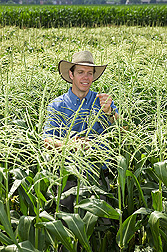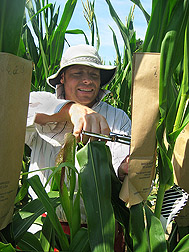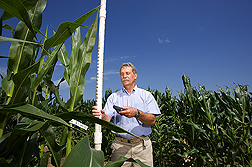Opening Up a New World of Maize Traits
Maize, or corn, is the most diverse crop species known. On average, two maize lines can be as genetically different as a human is from a chimpanzee, and such diversity can make sorting out the genetic basis of key traits particularly challenging. But a specially designed collection of maize lines is so large, diverse, and well-characterized that it has become a powerful and widely used genetic tool for researchers around the world who search for genes to enhance the crop’s desirable traits.
This collection of maize lines, called the “Nested Association Mapping” (NAM) population, has been developed by Agricultural Research Service scientists over the past several years by crossing a commonly studied corn variety (B73) with 25 diverse lines and repeatedly self-fertilizing the offspring to create 5,000 inbred lines, each with a unique combination of the parental lines’ genetic traits. The resulting plants, grown at ARS sites near Ithaca, New York; Raleigh, North Carolina; and Columbia, Missouri, are tagged in the field with bar codes, and their growth rates and other characteristics are carefully measured.
The project team includes Ed Buckler, a plant geneticist at the ARS Robert W. Holley Center for Agriculture and Health in Ithaca; plant geneticist Jim Holland in the ARS Plant Science Research Unit in Raleigh; plant geneticists Michael McMullen and Sherry Flint-Garcia in the ARS Plant Genetics Research Unit in Columbia; and Stephen Kresovich, a former Cornell University plant geneticist who is now vice president for research and graduate education at the University of South Carolina.
|
|
The NAM strategy consists of compiling two data sets—detailed genome-sequencing data from the parent plants and a broader glimpse of the genetic details in the larger population—that can be cross-referenced to provide detailed genetic descriptions of all 5,000 lines. “If you want to look at the diversity of maize, with the 25 lines we chose as parents, this is as good as it gets,” says Buckler, a cofounder of the project.
Buckler, Holland, McMullen, Flint-Garcia and others are using the NAM lines to search for quantitative trait loci (QTLs) and other signposts along the corn genome that can be linked to desirable qualities and traits. QTLs are stretches of DNA that might encode different combinations of traits.
The collection of NAM lines has proved invaluable not only to ARS scientists, but also to researchers at a dozen universities and a number of seed companies that use the lines to study a range of traits, including drought tolerance, disease resistance, and dozens of features related to nutritional quality and biofuel development. The work is addressing both practical and basic scientific questions, such as whether a few genes produce major effects or many genes produce minor effects, or whether some combination of both occurs. “It’s one of the first systematic ways to organize and map the genetic diversity of maize from around the world,” Buckler says.
Taking a Deeper Look at Photoperiod Sensitivity
|
|
Having developed the NAM population, Holland, Buckler, and their colleagues are now taking a closer look at some of the genes that control flowering time and a related characteristic known as “photoperiod sensitivity,” or sensitivity to day length.
The origins of maize can be traced to tropical Latin America. There, maize plants flower as the days grow shorter. When maize was carried from the tropical regions to temperate regions of the Americas, it had to adapt to the longer day lengths found during the summer in the temperate regions. Today, this adaptation is a major genetic difference between tropical and temperate maize.
“Tropical maize possesses genetic diversity that could be used to improve maize in temperate regions, such as the United States,” explains Holland. “But because tropical maize flowers very late when grown under long day lengths, undesirable traits such as poor yield can mask other favorable traits such as disease resistance. Our goal is to better understand the mechanisms behind photoperiod sensitivity so we can access the genetic diversity of tropical maize more easily.”
Buckler also says that understanding flowering time in corn would help in understanding it in other plant species. For example, if researchers want to move genetic material around within a plant’s genome to improve another trait, they need to know where flowering is controlled in the genome. “We don’t want to move a gene variant for disease resistance and inadvertently affect flowering time,” Buckler says.
|
|
In findings published last year in Science, the team reported that the large differences in flowering time among different lines of maize are caused by the cumulative effects of up to 56 QTLs, but that overall, each QTL has a relatively small effect.
“For an outcrossing species like maize, there are generally lots of genes with little effects. But if you line up these little effects together, you can do some very big things,” Buckler says.
Tropical-Temperate Crosses
In a separate project, Holland’s team crossed two tropical, photosensitive maize lines with two temperate maize lines. The tropical lines—one from Mexico, the other from Thailand—were chosen because they flower very late under the long day lengths of the U.S. Corn Belt. Including them in the study also helped Holland compare photoperiod response in tropical maize from different regions. The temperate lines represented the two main breeding pools found in the United States.
Through genetic mapping, the team sufficiently narrowed the maize genome to pinpoint four QTLs that are associated with photoperiod sensitivity. These QTLs—named “ZmPR1–4” by the researchers—represent 2 percent of the genetic map.
To genetically characterize their lines, Holland’s team used molecular markers originally developed by Buckler and McMullen for the NAM population. Although Holland’s lines were developed independently of the NAM population, they are now being integrated as an extension of the NAM population, because both populations were mapped using the same molecular markers.
|
|
“We also compared the QTLs responsible for photoperiod sensitivity with similar ones found in model plant species, such as Arabidopsis and rice,” says Holland. “We found related genes in maize and the model species—but not in the same important genomic regions. Some of the known photoperiod regulators in Arabidopsis and rice do not appear to be major photoperiod regulators in maize.”
Holland is currently confirming that the QTLs found in the tropical-temperate crosses are also important in the NAM population. “If we can focus on a few genome regions to select for genes that permit earlier flowering under long day lengths, the offspring will be better adapted to the long day lengths of temperate regions. Breeders can then focus on incorporating desired traits, such as increased yield and disease resistance, into U.S. maize varieties.”
|
|
Analyzing Recombination Effects
In Columbia, McMullen and collaborators genotyped 4,699 lines of the NAM population and were able to analyze 136,000 “recombination events,” areas where the parental genes recombined. McMullen is a co-principal investigator of the project and leads genetic map construction of the NAM population—conducting gene sequencing, population development, genetic assays, and measuring plant traits in the field.
McMullen’s genetic mapping work has revealed enormous differences among families of corn plants with regard to recombination rates, which are the frequencies of physical exchanges of chromosomal portions from the different parents of a cross. They found that recombination rates are lower in the center of the chromosomes than in the chromosome ends.
“This limits the possibilities for selecting a superior line. To be able to generate the best combinations of beneficial genes in a plant, you need strong recombination rates,” says McMullen. “And that’s a problem over much of the corn genome.” The findings, also published in Science in 2009, highlight a challenge for the scientists: How to improve recombination rates in the central regions of the maize chromosomes.
Also in Columbia, Flint-Garcia is using NAM to understand the genetic control of kernel composition traits, such as starch, protein, and oil. She specializes in plant breeding, and her results could be used to genetically custom design corn kernels to fit the various oil-, starch-, and protein-content needs of farmers and end users.
“When designing maize for ethanol production, high starch is preferred,” says Flint-Garcia. “Poultry farmers prefer their maize feed to have high oil content.”—By Dennis O'Brienand Stephanie Yao, Agricultural Research Service Information Staff and Alfredo Flores, formerly with ARS.
The research is part of Plant Genetic Resources, Genomics, and Genetic Improvement, an ARS national program (#301) described at www.nps.ars.usda.gov.
To reach scientists featured in this article, contact Dennis O’Brien, USDA-ARS Information Staff, 5601 Sunnyside Ave., Beltsville, MD 20705-5129; (301) 504-1624.
"Opening Up a New World of Maize Traits" was published in the September 2010 issue of Agricultural Research magazine.












